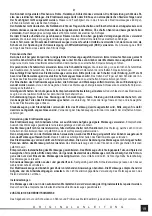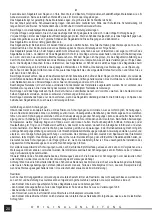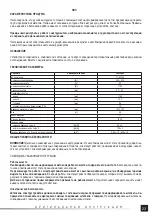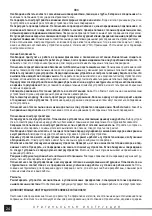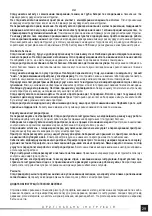
16
GB
O R I G I N A L I N S T R U C T I O N S
wheels and help release the saw blade and mount the new one.
Clean the gap in which the saw blade and its driving wheels move with a soft brush or compressed air at a pressure up to 0.3 MPa.
Slide the saw blade into the slot (IV) so that it rests on the edge surface of both driving wheels.
The saw blade teeth must point to the outside of the gap (V).
Slide the saw blade between the guide rollers (VI) on both sides of the cutting area.
Turn the blade tension lever as far as it will go towards the “+” mark to increase the distance between the driving wheels and
properly tension the saw blade.
Check that the saw blade has not slipped off the driving wheels and/or slipped out from between the guide rollers.
Saw blade speed control (VII)
The saw blade speed can be adjusted within the range specifi ed in the Technical Data table. The saw blade speed is adjusted with
the blade speed control knob. The higher is the number visible on the knob, the higher the saw blade speed is.
Working area lamp (VIII)
The LED lamp is turned on by moving its switch to “I”. The LED lamp is turned off by moving its switch to “O”.
Starting the band saw
Mount the saw blade and set the maximum saw blade speed.
Make sure that the ON/OFF switch is set to OFF. Plug the power cord into a mains outlet.
Hold the band saw by both handles (IX). Adopt a balanced posture. Make sure that the saw blade will not touch any object when
staring the band saw. Start the band saw by pressing and holding the ON/OFF switch. Wait for the saw blade to reach is full speed
and hold the band saw steady for about one minute.
In the meantime watch the band saw for any abnormalities. If strong vibration, high noise, odour or smoke is noticed, immediately
turn off the bad saw by releasing the ON/OFF switch, wait for the saw blade to stop completely, put the band saw away and unplug
the power cord from the mains outle. Do not restart the band saw before removing the cause of the abnormality.
If no signs of abnormal performance are found when starting the band saw, turn it off and unplug the power cord from the mains
outlet. Next, check that the saw blade has not slipped off the driving wheels and/or out of the guide rollers. Mount the saw blade
properly, if needed.
Cutting materials
Warning! Do not use any coolants, e.g. water or oil during cutting. The band saw is only suitable for dry cutting. Exposure of the
band saw to water or liquids may result in electrical shock and serious injury or death.
Before you start cutting, prepare the workpiece. Check if the size of the workpiece is within the cutting range limits.
Mark the cutting line on all surfaces of the material the cut will be made on. This will help the saw blade run properly through the
workpiece.
The material to be cut should be fi xed. Use a vice, a clamp or other suitable fi xtures or supports. If you want to cut a long material,
support the workpiece near the location of the cut and at the opposite end. The workpiece must be supported on both sides of
the cut. The supports must prevent the workpiece parts being separated by the cut from collapsing inward, which may cause the
saw blade to stick in between.
Keep the guide bar touching the workpiece throughout the cut.
Do not apply excessive pressure on the workpiece and/or an excessive saw blade speed. Establish the proper pressure and saw
blade speed experimentally by trying to cut scrap material.
Watch the colour of the swarf and the edges of the cut. If discoloration becomes visible, the temperature is rising too high at the cut
due to excessive pressure on the band saw and/or an excessive saw blade speed. When cutting metals other than steel, excessive
pressure and/or band saw speed may cause caking of the saw blade teeth with the swarf. This will reduce the cutting performance.
Too much pressure and/or speed accelerates the wear of the saw blade. If you notice a drop in the blade teeth sharpness or
broken teeth after a cut, replace the saw blade with a new one. Reduce the pressure and/or the saw blade speed when cutting.
Apply the band saw to the workpiece at an angle to the surface of entry (X) to facilitate the engagement of the teeth. Apply the
slightest pressure possible and a lower saw blade speed at the start of the cut. With the cut groove properly formed, you can
increase the pressure and/or the saw blade speed as required to cut effi ciently.
Band saw base
The band saw features a base that makes cutting easier and reduces the risk of the saw blade tilting sideways and bending within
the cut.
Warning! Turn off the band saw and unplug the power cord from the mains outlet before mounting the band saw on its base.
Mount the band saw on the base with the screws (XI). Place a spring washer and a plan washer under the head of each screw.
Check the tightness of the screws before starting the band saw and retighten them if necessary.
Place the base on a hard, level and fl at surface.
The base has a clamp to immobilize the workpiece. Lift the clamp lever and move the clamp arm. Place the material to be cut
between the stop plate and the clamp (XII).
Turn the clamp lever (XIII) into position and check that the clamp arm cannot move. If the clamp lever does not lock the clamp arm,
Summary of Contents for YT-82185
Page 24: ...24 RUS...
Page 25: ...25 RUS...
Page 26: ...26 RUS II III 0 3 IV V VI VII VIII I O IX...
Page 27: ...27 RUS X XI XII XIII XIV XV XVI 0 3 TOYA www toya pl...
Page 29: ...29 UA...
Page 30: ...30 UA a E a...
Page 31: ...31 UA II III 0 3 IV V VI VII VIII IX...
Page 32: ...32 UA X XI XII XIII XIV XV XVI 0 3 TOYA www toya pl...
Page 84: ...84 GR RCD RCD...
Page 85: ...85 GR...
Page 86: ...86 GR 0 3 MPa IV V VI VII VIII FF IX...
Page 87: ...87 GR XI XII XIII XIV XV XVI...


















